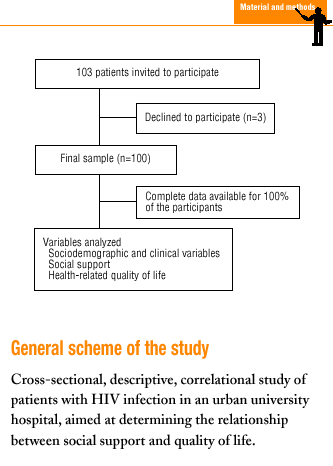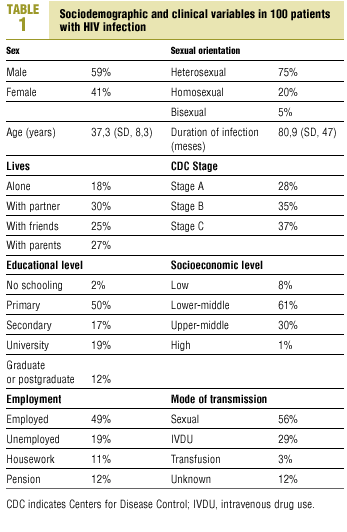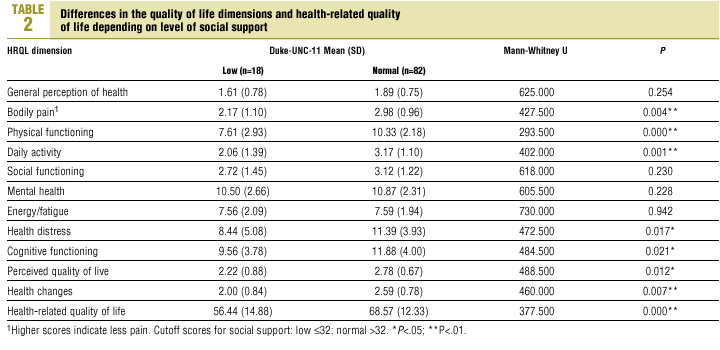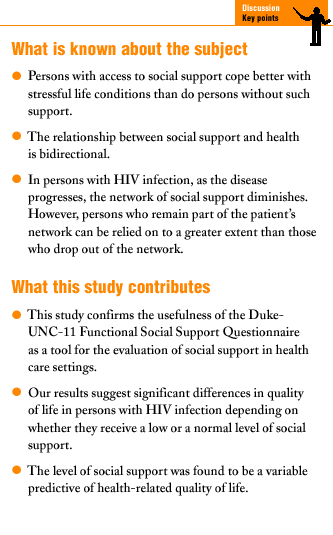En el mismo sentido, a través de la ecuación de regresión lineal, el nivel de apoyo social ha demostrado ser una variable predictora de la CVRS. Conclusiones. El apoyo social es una variable importante en la comprensión del bienestar y calidad de vida de las personas con infección por el VIH. Dirigir esfuerzos para la mejora de este recurso personal contribuye directamente a un aumento de la calidad de vida de estos pacientes.
Introduction
Since the 1970s the phenomenon of social support is a topic that has attracted much attention from health science researchers.1 Such interest arose empirically from data suggesting that social support might be useful for maintaining good health and improving the health of sick persons. Specifically, it was postulated that social support might be an important variable in the prevention of psychopathologies2,3 and diseases in general, through the so-called buffering hypothesis.4,5 In other words, it has been argued that persons who enjoy social support are better at coping with stressful life conditions than are persons who do not have the benefit of such support.
The relationship between social support, depression, coping and health appears to be especially important for persons who live with HIV. For example, a study by Zich & Temoshok6 of 103 gay and bisexual men with AIDS or AIDS-related complex found evidence that HIV-positive persons with low social support had more physical symptoms, more hopelessness and more depression than persons with high levels of social support. Another study found that the lower availability of perceived social support was associated, in HIV-positive men, with the greater use of avoidance coping strategies and greater mood disorder, including higher levels of self-reported depression and anxiety and lower levels of vigor.7 Similarly, another study of a sample of 50 men with AIDS reported that social support was related with physical and mental health. Specifically, instrumental or tangible help was the only variable that was significantly predictive of physical health scores and was significantly associated with mood disorders.8
Kaplan, Patterson, Kerner and Grant9 approached the relationship differently and tried to disentangle cause and effect. These authors proposed an alternative explanation according to which low social support is a consequence, rather than a cause, of poor health status. Their longitudinal study of a sample of 397 HIV-positive homosexual and heterosexual men found that the size of the subject´s social network decreased as the disease worsened. Moreover, their data indicated that advancing disease preceded, rather than followed, a decline in social support, and that in fact, instrumental social support improved as the infection progressed. In other words, as the disease progressed, HIV-positive men may have fewer people in their social network, but can rely more on those who remain in the network than on those who drop out. In the light of these results it was suggested that the relationship between social support and health or illness ought not to be conceptualized and studied as a predictor of health outcomes, as changes in social support can also be a consequence (rather than a cause) of the disease. Moreover, the influence can be reciprocal, that is, bidirectional. A cross-sectional study by Remor10 reported similar results: the perception of support from the patient´s partner and family increased as the disease progressed in terms of Centers for Disease Control criteria.
The present study sets out to answer the following questions: a) is health-related quality of life (HRQL) worse in subjects with low social support than in those with normal social support?, and b) what is the relative weight of social support in predicting quality of live in HIV-positive persons?
Material and methods
The study involved 100 persons of both sexes at different stages of HIV infection, who were followed at the Internal Medicine Service and HIV Unit of the La Paz University Hospital in Madrid. The criteria for inclusion in the sample were age older than 18 years and HIV-positivity. The criteria for exclusion were drug use in the preceding 6 months and refusal to provide informed consent to participate.
Measures and instruments
Sociodemographic and clinical data. The participants provided information, via a self-administered questionnaire, on age, sex, sexual orientation, socioeconomic level, employment status, educational level, persons in the household and mode of transmission of HIV. Information about clinical and immunological profile, including Centers for Disease Control(CDC) classification, viral load, CD4 T lymphocyte count and months of HIV infection, was obtained from the medical record.
Social support. Social support was evaluated with Duke-UNC-11 Functional Social Support Questionnaire11 validated for the general population12,13 and the HIV-positive population14 in Spain. The responses on this 11-item questionnaire are chosen from a 5-point Lickert scale where 1 represents «as much a I would like» and 5 represents «much less than I would like». The instrument consists of two subscales for confidant (having persons to talk to) and affective support (manifestations of love, affection and empathy). The higher the total score, the higher the level of social support. Internal consistency of the scale (Cronbach´s alpha) and two subscales (confidant and affective support) for the sample was 0.91, 0.86 and 0.87, respectively.
Health-related quality of life (HRQL). Health-related quality of life was evaluated with the a 30-item short form of the Medical Outcomes Study (MOS) Health Survey15 validated for HIV-positive population in Spain.10,16 This instrument is divided into 11 subscales that measure general perception of health, bodily pain, physical functioning, social functioning, mental health, energy or fatigue, limitations in physical activities because of health problems, health distress, cognitive functioning, perceived quality of life and perceived change in health. Each subscale was scored directly, with higher scores on each subscale indicating better quality of life. The total HRQL score, obtained as the sum of the scores on each subscale, ranged from a minimum of 0 (worst possible quality of life) to a maximum of 100 (best possible quality life).
Procedure
The study was done during the period from February to April 1999. Four consecutive patients per day were chosen on the basis of the inclusion and exclusion criteria specified earlier. This was repeated until the sample consisted of 100 participants. Both questionnaires were administered by a psychologist at the end of the patient´s regular visit with the physician. The aims of the study were explained briefly to each patient, and participation was voluntary. Volunteers signed an informed consent declaration in which they agreed to the conditions of the study. Only three of the patients we interviewed declined to participate. Those who agreed to take part completed the questionnaires immediately thereafter, in the presence of the interviewer.
Analyses
An initial descriptive analysis of the sample was based on frequency analysis and calculation of mean and percent values for the variables considered in the study. To evaluate the reliability of the Duke-UNC-11 scale for our sample we checked internal consistency (Cronbach´s alpha) for each subscale and for all items globally. To verify the differences in social support and HRQL associated with sociodemographic variables (regrouped as dichotomous variables), we used Student´s t test (n>30) and Mann-Whitney´s U test (n<30). To identify the differences in level of social support (i.e., low or normal) associated with HRQL dimensions as the dependent variable, we used the nonparametric Mann-Whitney U test; this approach was used because of the dissimilar size of the groups and the ordinal nature of the variables. The cutoff point was chosen on the basis of criteria established in the course of validation of the instrument for the Spanish population.13 Simple linear regression analysis was used to study the ability of social support to predict HRQL. All analyses were done with the Statistical Package for Social Sciences (SPSS, v. 9.0 for Windows).
Results
The sociodemographic data are summarized in Table 1.
Mean score on the Duke-UNC-11 was 40.89 (SD 10.20, range 16-55), and the median score was 42. On the confidant support subscale, mean score was 25.47 (SD, 6.70; range, 10-35), and the median score was 26. On the affective support subscale, mean score was 15.42 (SD, 4.12; range, 4-20), and the median score was 16. No significant differences were found for social support associated with the socioeconomic variables sex, age, persons in the household, occupation and socioeconomic level; however, the level of social support differed between patients with no formal education or primary level education (mean score 38.40) and those with secondary level education (mean score, 43.58; t=2.608; df=98; P=.01).
Mean score for HRQL was 66.39 (SD, 13.58; range, 30-99), with a median of 69. We found no significant differences in HRQL associated with the sociodemographic variables age, sex, persons in the household, educational level or socioeconomic level; however, HRQL was significantly higher in employed (mean, 71.63) vs. unemployed participants (mean, 63.93; t=2.730; df=98; P=.008).
To determine the differences in social support (low, normal or high) on the basis of HRQL as the dependent variable, Mann-Whitney´s nonparametric U test was used (Table 2). To determine the relative weight of social support in predicting HRQL, simple linear regression analysis yielded figures for the relation between these factors, as shown schematically in Figure 1.
Fig 1 Scheme of the relationship yielded by linear regression analysis with health-related quality of life as the criterion (R2=0.139). HRQL=health-related quality of life
Social support was a predictor of HRQL in HIV-positive subjects at different stages of HIV infection (F=15.883; P=.000). However, although the relationship found with the regression model was statistically significant, this result should be regarded with caution as the results indicated that the ability of the model to predict HRQL from a single variable was discreet.
Discussion
Mean score for social support in the HIV-positive participants of this study was 40.89, a figure higher than the mean score reported in the first validation study for the Spanish population (35.55)12 and slightly lower than the mean score in the second Spanish validation study (42.73).13 It should be noted that the latter two studies included HIV-negative subjects. The median score in a study by Revilla et al.14 of intravenous drug users (IVDU) who were HIV-positive was 33, a figure much lower than the score of 42 we obtained for this subpopulation. Because this study did not include information on other variables,14 it was not possible to perform further comparisons.
The differences between mean and median scores may have arisen from cultural, socioeconomic or demographic differences between the populations in each study. Taking as an example a common indicator such as age, mean age of the participants in the present study was 37.3 years, whereas in the studies mentioned above12-14 mean age was 46, 50.6 and 29.4 years. With regard to HIV-positive populations we note that use of drugs during the 6 months prior to recruitment was an exclusion criterion, whereas the 1994 study14 investigated active IVDU. The results indicate the need for standardized psychometric variables for specific age groups, educational levels and the presence or absence of disease. In view of the present findings and the overall results of earlier studies, the degree of social support can vary depending on the subject´s age, educational level or presence of certain diseases. These analyses might be of key importance for future research with the Duke-UNC-11.
The main aims of this study were: a) to determine how social support and HRQL are related, and whether low social support implied worse quality of life, and b) to establish the relative weight of social support in predicting HRQL. Therefore we first investigated whether subjects with low social support have a worse HRQL than subjects with normal social support. Our findings show that the answer to this question is «Yes». Subjects with low social support (defined as a score below the cutoff recommended by the most recent Spanish validation study13) had worse perceived health, more pain, worse physical functioning, greater difficulties with daily activities, more health-related distress, worse cognitive functioning, worse perceived quality of life, worse physical and emotional health than in the preceding month, and, in overall terms, worse HRQL than participants with a normal or high level of social support.
Because an individual´s HRQL can vary depending on his or her social support, what relative weight does social support have for predicting the quality of life in persons who are HIV-positive? The linear regression equation indicates that social support is able to predict 13% of the variance in HRQL; this indicates that persons who are more satisfied with their social support also enjoy a better HRQL. Similar results were found in a study of hospitalized hemato-oncological patients: social support, together with the degree of comprehension of the information received and satisfaction with the health care team, was a predictor of the patient´s well-being.17
The results of the present study raise the question of how primary care can contribute to extend social support to persons with HIV infection, and how it can improve their HRQL. All such patients can potentially benefit from one key tool: counseling (nondirected assessment). By using assertive communication and active listening, we can help to better inform our interlocutors, indicating and educating them in ways to seek potential social and community resources, and helping them to extend their support network. As we help them to express emotions and train them in communicating clearly and openly with the persons in their environment, we can facilitate the development of their personal resources so that they can use their self-determination to work toward developing confidant and affective support in their relationships. Lastly, health professionals who are able to establish this type of helping relationship with their patients will help improve the amount and quality of social support these persons receive, in addition to enhancing their quality of life. These steps will ultimately help to improve the quality of health care.
Acknowledgments
The author thanks the staff of the HIV Unit of the Internal Medicine Service, coordinated by Dr. J.M. Peña, at the La Paz Hospital in Madrid, for their help in providing access to the sample of patients this study is based on.
Correspondence: Eduardo Remor. Departamento de Psicología Biológica y de la Salud. Facultad de Psicología. Universidad Autónoma de Madrid. Ciudad Universitaria de Cantoblanco. 28049 Madrid. España. E-mail: eduardo.remor@uam.es

















